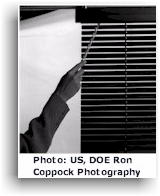

Window Film
Exterior Shading Devices
Energy-Efficient Landscaping
White Roofs
Window Film
Sunlight entering through windows can greatly increase the cooling load in a building.
Interior window films can be used to reduce the heat gain through glass without
eliminating visibility. Typically, installing a reflective window film over clear glass
will reduce cooling costs by 5% to 15%. Also, take the opportunity to check for cracks
around your windows, and seal them with appropriate caulk or weather stripping. Window
films are attached to the interior of an existing window with adhesive backing and are
typically tinted or reflective, making the window appear dark. Look for the latest
technology in spectrally selective films that permit daylight to enter the building while
blocking solar heat gains. Most window film manufacturers require professional
installation in order to offer warranties. Installed costs of window films range from $1
to $5 per square foot.
 |
Exterior Shading Devices Exterior shading devices can reduce heat loss in the winter and heat gain in the summer generated by sunlight shining through glass. These can be in the form of insulating shades, shutters, drapes, solar screens, and awnings. Many of these devices, such as awnings, enhance the facade of the building and improve energy efficiency. Actual savings will vary, and will be dependent on such factors as building orientation, proximity to neighboring structures, etc. During the winter, make sure to open these shading devices in the daytime to receive the benefit of heat from the sun. In most cases, these window treatments are more cost-effective than energy-efficient window replacements and should be considered first. |
Energy-Efficient Landscaping
Landscaping is a natural and beautiful way to keep your facility more comfortable and
reduce your energy bills. In addition to adding aesthetic value and environmental quality
to your facility, a well-placed shade tree, shrub, hedge, arbor, or vine can deliver
effective shade, act as a windbreak, and reduce overall energy bills. Carefully positioned
trees can save up to 25% of a typical facility's energy for heating and cooling. Computer
models from the Department of Energy predict that just three trees, properly placed around
the facility, can save an average small business between $100 and $250 in heating and
cooling energy costs annually. During the summer months, the most effective way to keep
your facility cool is to prevent the heat from building up in the first place. A primary
source of heat buildup is sunlight absorbed by your facility's roof, walls, and windows.
Dark-colored building exteriors absorb 70% to 90% of the radiant energy from the sun that
strikes the facility's surfaces. Some of this absorbed energy is then transferred into
your facility by way of conduction, resulting in heat gain inside the building. In
contrast, light-colored surfaces effectively reflect most of the heat away from your
facility. Landscaping can also help block and absorb the sun's energy to help decrease
heat buildup in your facility by providing shade and evaporative cooling. Shading and
evaporative cooling from trees can reduce the air temperature around your building.
Studies conducted by the Lawrence Berkeley National Laboratory found summer daytime air
temperatures to be 3° to 6°F cooler in tree-shaded areas than in treeless areas. The
energy-conserving landscape strategies you should use for your facility depend on the type
of climate in which you live.
Buildings and Trees – Natural Partners
Deciduous trees planted on the south and on the west will help keep your facility cool in
the summer and allow sun to shine in the windows in the winter.
Landscaping Tips – Dependent on Geographic Area
- Trees that lose their leaves in the fall (i.e., deciduous) are the most effective at reducing heating and cooling energy costs. When selectively placed around a building, they provide excellent protection from the summer sun but permit winter sunlight to reach and warm your facility. The height, growth rate, branch spread, and shape are all factors to consider in choosing a tree.
- Vines provide shading and cooling. Grown on trellises, vines can shade windows or the whole side of a building.
- Deflect winter winds by planting evergreen trees and shrubs on the north and west sides of your facility; deflect summer winds by planting on the south and west sides of your facility.
Orientation of the building and surrounding landscaping has a large effect on energy consumption. A well-oriented, well-designed building admits low-angle winter sun to reduce heating bills; rejects overhead summer sun to reduce cooling bills; and minimizes the chill effect of winter winds. Fences, walls, other nearby buildings, and rows of trees or shrubs block or channel the wind. Bodies of water moderate temperature but increase humidity and produce glare. Trees provide shade, windbreaks, and wind channels. Pavement reflects or absorbs heat, depending on whether it is light or dark in color.
White Roofs
Just as wearing white clothes reflects the sun's heat from your body, a white or
light-colored roof will help reflect the sun's heat away from your building. This strategy
works particularly well when trees are located next to the reflecting surface. Not only
does the tree provide shade, it absorbs the reflected sunlight for photosynthesis. In the
process, water evaporates from the tree, cooling the air around the facility.
Contact your county extension agents, public libraries, local nurseries, landscape architects, landscape contractors, and state and local energy offices for additional information on energy-efficient landscaping and regional plants and their maintenance requirements.
|
|

|
| Copyright Aclara Technologies LLC. All Rights Reserved. | |